This article first appeared in the May/Jun 2010 issue of World Gaming magazine.
JOHANNESBURG is the largest city in South Africa. It is also the capital of the most urbanised and wealthy province, even though in land mass it is the smallest in the country. It is home to over seven million people, and the surrounding areas are famous for their gold and diamond mines.
Johannesburg is located on the eastern plateau known as the Highveld, and is 1,753 metres above sea level. The city enjoys a subtropical highland climate with mild summers and winters. In winter it is usually dry, but can be subjected to very cold southerly winds with clear skies.
Soccer City is located next to the South African Football Association headquarters in the Soweto township. The stadium, which hosted the 1996 African Cup of Nations final, has since undergone extensive upgrading, with an extension of the upper tier to increase the capacity to 94,700.
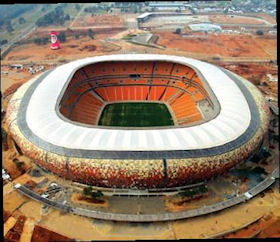
Soccer City Stadium
The outside of the stadium is designed to have the appearance of a calabash, an African cooking pot. No spectator will be more than 100 metres (330ft) from the action and there are no restricted views in the stadium. Soccer City will host the World Cup Final.
Ellis Park Stadium is located right in the centre of Johannesburg. Prior to hosting the final of the 2009 FIFA Confederations Cup final the stadium was upgraded, increasing the capacity from 57,000 to 62,000. It is home to the Lions rugby union team, the PSL (Premier Soccer League) Moroka Swallows and the best supported PSL club, Kaiser Chiefs. This stadium will always be remembered for holding one of the most important events in South African history. In 1995 the country was united through the scene of Nelson Mandela and Springbok captain, Francois Pienaar holding aloft the Rugby World Cup in 1995.

Ellis Park Stadium
DURBAN is the third most populated South African city, with 3.5 million people. Located in the southeast of the country, Durban is a coastal city overlooking the Indian Ocean. The city was built on the back of the sugar cane industry, and has a large Indian population that was brought over to work the sugar cane in the 1800s.
Durban is characterised by a mild subtropical climate with wet summers and mild dry winters. Durban is the busiest port in Africa, and a major centre of tourism. Its incredible hills, mostly warm weather and long sandy beaches make it a popular holiday destination.
Moses Mabhida Stadium is situated in the Kings Park Sporting District of Durban, with the area also home to other international rugby and cricket stadiums.
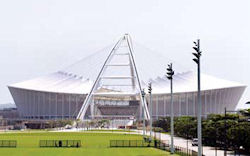
Moses Mabhida Stadium
The Moses Mabhida Stadium was completed in November 2009, and has a capacity of 70,000. The roof is made of Teflon-coated, glass-fibre membranes which produce a translucent glow when the stadium is lit. The stadium has a 106 metre high-span arch that is similar in design to Wembley Stadium in London. A funicular cable railway will carry visitors to a viewing platform at the top of the arch, from which people can enjoy spectacular breathtaking panoramic views of the city and the ocean.
CAPE TOWN is the largest city in South Africa in area, and second largest in terms of population. Situated in the Western Cape, the province has a shoreline on the Indian Ocean in the east and the Atlantic Ocean in the west. The city enjoys a more Mediterranean climate than other parts of the country. It can get rather hot in summer, and the winters are cold and can get quite wet.
It has incredibly lush vegetation, and Table Mountain and the Cape Point region are places tourists flock to enjoy the flora and fauna of Southern Africa. Killer Whales can be seen throughout the year, as can dolphins which are endemic to the area. It is the most tourist-friendly place in the country with excellent beaches, fantastic dining and night-time entertainment. Cape Town is also noted for its architectural heritage, with its high density of Cape Dutch style buildings – which combine the architectural traditions of the Netherlands, Germany and France.
Green Point Stadium is new, with a capacity of 70,000. It is near the centre of Cape Town and serviced by new roads and park lands, which include a 60 hectare urban park.
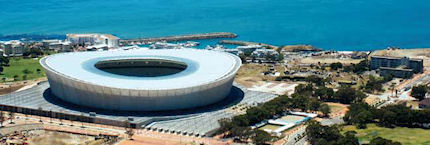
Green Point Stadium
The multi-purpose stadium will provide the future home for Premier Soccer League clubs Ajax Cape Town and Santos. Green Point is sure to turn plenty of heads as it sits right on the ocean, with the mountains of Cape Town providing a dramatic backdrop.
PRETORIA is situated in the northern part of Gauteng Province and has a population of 2.3 million. It lies at an altitude of about 1,350m (4,500ft) above sea level, in a warm, sheltered, fertile valley, surrounded by the hills of the Magaliesberg range.
Pretoria has a humid subtropical climate, which is a little surprising due to its altitude. The average annual temperature is just under 19 degrees, but during winter it won’t be that hot. The good thing is that most of the rain usually falls in the summer.
Sport is the local religion, and the Blue Bulls Rugby team is one of the most feared club teams in the world.
Loftus Versfeld Stadium was named after Robert Owen Loftus-Versfeld, the founder of organised sports in Pretoria. The ground was formerly known as the Eastern Sports Ground, but was renamed after him as a tribute to a man who had done so much to develop sport in the area.
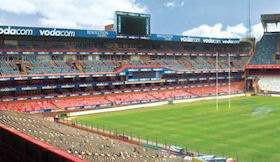
Loftus Verfeld Stadium
The stadium is located in the heart of Pretoria and now has a capacity of just over 50,000 since its most recent upgrade in 1984. It hosts international rugby and also acts as a football ground. It will always be, however, the home to those fierce Blue Bulls.
PORT ELIZABETH is one of the largest cities in South Africa, and part of the Nelson Mandela Bay Metropolitan Municipality which covers 1,844 square kilometres. It has a population of 1.3 million, is located in the Eastern Cape, and sits on the Indian Ocean. Port Elizabeth has a subtropical climate with light rain throughout the year. Winters are cool but mild; summers are warm but considerably less humid and hot than more northerly parts of South Africa’s east coast.
The city is the home of South Africa’s motor vehicle industry and is also a major seaport, with the largest ore loading facilities in the southern hemisphere. The city is also one of South Africa’s major destinations for tourists who come to enjoy the many fine beaches and the water sports that include fishing, diving, surfing and whale watching. Port Elizabeth also has the oldest cricket ground in South Africa: St. George’s Park, a test match ground that is a regular venue for overseas touring sides.
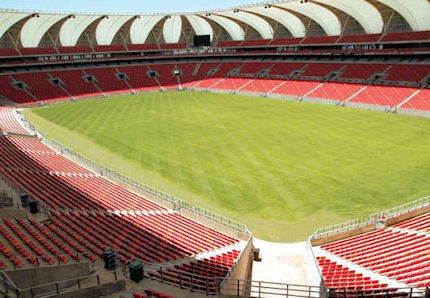
Nelson Mandela Stadium
Nelson Mandela Bay Stadium is a 46,500 seat stadium. The five-tier stadium was built on the shores of the North End Lake, in the heart of Port Elizabeth. This new multi-purpose stadium is just two kilometres from the ocean, located near the industrial port development of Coega, with close proximity to the main highway, and access to the ground from the city centre is easy and fast.
As this stadium is named after the great man himself, it is sure to be a spiritual place perfect for World Cup football.
BLOEMFONTEIN is the judicial capital of South Africa. It is also the provincial capital of South Africa’s breadbasket. Free State Province, which is situated on flat boundless plains in the heart of South Africa, has rich soil and a perfect climate for a thriving agricultural industry. With more than 30,000 farms, the province produces over 70 percent of the country’s grain.
Bloemfontein was built on dry grassland at an altitude of 1,395 metres above sea level. It has a small sports-loving population of fewer than half a million residents. It can get very hot there in summer, but is known for its lovely crisp, dry winters.
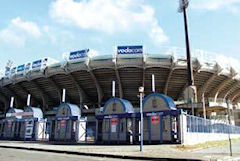
Free State Stadium
Free State Stadium, which is also known as Vodacom Park, is used for both rugby and football matches. It is home to the PSL football club Bloemfontein Celtic and the Free State Cheetahs rugby team.
The stadium was given a face-lift for the 2009 Confederations Cup. A second tier was added to the main grandstand on the western side of the ground, increasing the capacity from 36,000 to 48,000. Additionally, the floodlights were upgraded, electronic scoreboards installed, and the overall sound system – together with the existing media facilities – underwent substantial improvements.
POLOKWANE is South Africa’s largest northern city. It borders Zimbabwe, Botswana, and Mozambique, which makes it quite an interesting place. With a population of just over half a million, it sits on the Tropic of Capricorn and has a mainly dry climate – especially over winter.
There are many wildlife viewing opportu¬nities, making Polokwane a popular ecotourism destination in Southern Africa. The city is considered the premier hunting destination in South Africa, which is allowed under strict controls. The Pietersburg Game Reserve has more than 21 game species and offers scenic walks.

Peter Mokaba Stadium
Peter Mokaba Stadium is a purpose-built football stadium in Polokwane with a capacity of 46,000. It was named after Peter Mokaba, a former leader of the ANC Youth League, and is situated five kilometres from the centre of the city.
The design of the largely concrete structure is inspired by the locally iconic Baobab tree, with the steel structure supporting the roof plane gathered together at each corner of the stadium and supported by giant ‘tree trunk’ structures, which accommodate vertical circulation ramps and service cores.
NELSPRUIT is a small city of just under one quarter of a million people. The city borders Mozambique and Swaziland, and the southern half of the Kruger National Park is located in Mpumalanga Province.
Located on the Crocodile River, the city is known for its wood industries and fruit growing, and is a major stopover point for tourists travelling to the Kruger National Park.

Mbombela Stadium
Mbombela Stadium is a new 43,500-seat stadium that is going to be used for a wide variety of sports after the World Cup. The stadium is located on open land, six kilometres west of Nelspruit city centre.
The signature feature of the stadium is the 18 roof supports that resemble giraffes, which celebrates the city’s closeness to nature and the National Park. Visitors to this World Cup venue will be able to couple this with trips to the game reserve.
RUSTENBURG sits at the foot of the Magaliesberg mountain ranges, and the Vaal River flows along its southern border. Rustenburg is located on the Highveld Plateau and has an altitude of 1,500 metres, which makes for a climate ideal for year-round outdoor activities. It has a population of just under 400,000 people.
Kgaswane Game Reserve is situated above the city and is open to hikers as well as visitors in vehicles. The reserve offers a great range of viewing experiences to wildlife enthusiasts. Madikwe Game Reserve and Groot Marico is a huge reserve north of the city which is almost half the size of Belgium. Madikwe hosts all the major plains species, including the Big Five: rhinoceros, leopard, Cape Buffalo, elephant and lion; it has the second largest concentration of elephants in South Africa. The reserve is one of South Africa’s great natural treasures.
The Pilanesberg Game Reserve is one of the most accessible in South Africa, as it is located right outside Rustenburg.
A bit further out of Rustenburg, there are also the Sun City and Lost City resorts, where visitors can lose themselves in luxury. Casinos and two world-renowned championship golf courses are just some of the many attractions.
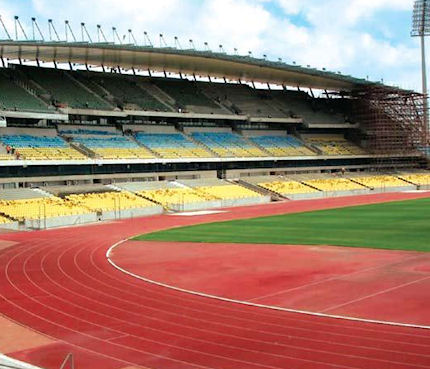
Royal Bafokeng Sports palace
Royal Bafokeng Sports Palace. The main west stand has been substantially upgraded, enlarged, and given a new cantilever roof, increasing the capacity from 38,000 to 42,000. Other improvements included the installation of new electronic scoreboards and seats, and upgrading of the floodlights and public address system. The stadium stages rugby union, football and athletics events.







